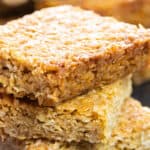Classic British Flapjacks
Made with oats, butter, brown sugar, and golden syrup, these buttery, sweet treats can be whipped up in no time! They're perfect for bake sales and after-school snacks.
Servings 12 bars
Calories 204
Ingredients
- ½ cup salted butter (1 stick) cubed
- ½ cup brown sugar packed
- 5 tablespoons golden syrup or dark corn syrup
- 1 teaspoon vanilla
- 2⅓ cups quick-cooking oats Or jumbo porridge oats in the UK - See notes on for other recommendations
Instructions
- Preheat the oven to 325°F/163°C (with the fan or convection setting turned off)
- Grease and line an 8-inch square baking pan.
- Melt the butter in a pan over medium-low heat. Add the brown sugar, syrup, vanilla and cook until the sugar is dissolved and fluid. Remove from heat and whisk until there is no visible melted butter and the mixture resembles melted caramel.
- Add the oats and mix until well coated.
- Spread the mixture into the prepared pan and press it down into the pan evenly with the back of a spoon or spatula.
- Bake until they start to firm. This will take 20–30 minutes, use the shorter cooking time for more chewy flapjacks and longer if you prefer them crisper. The flapjacks will firm and crisp more as they cool.
- Store covered at room temperature for up to 3 days.
Video
Notes
The number of servings will vary depending on what size you cut the flapjacks into.
- Oats In The US or Canada: Use quick-cooking oats — not instant oats and not old-fashioned/large-flake oats. Old-fashioned oats don’t absorb the syrup properly, so the bars won’t bind or get that classic chewy finish. Instant oats break down too much and make the flapjacks dense. Quick-cooking oats are the perfect choice that gives you the perfect texture every time. Oats In the UK: Porridge oats, jumbo porridge oats or rolled oats all work well. Porridge oats give a softer, chewier texture, while jumbo or rolled oats create a slightly firmer, more rustic flapjack. Avoid instant oats or instant porridge, as they break down too much and make the bars dense rather than chewy.
- Lining your pan with baking paper will make it easier to remove the flapjacks from the pan.
- Can’t find golden syrup? Use dark corn syrup in its place.
- When melting the butter and sugar together, cook over low heat. Higher heat can end up hard and taffy-like.
- To avoid a greasy flapjack, mix the butter and sugar mixture well until you see no sign of melted butter.
- When baking, watch closely and remove from the oven when the edges are golden. Overcooking may result in a hard, crunchy flapjack.
- For a crisper flapjack, use a shallower baking pan and bake at a higher temperature.
- For a more cake-like, fluffy flapjack, skip the stovetop and instead, add all the ingredients to a food processor, blitz it all together, and spread the mixture into the pan. Then bake as directed.
- If you don’t like a crisp edge, try using a damp cake wrap (paid link). This will cool down the sides and stop the edges from browning too quickly.
Nutrition
Calories: 204 | Carbohydrates: 26g | Protein: 1g | Fat: 10g | Saturated Fat: 6g | Cholesterol: 25mg | Sodium: 87mg | Potassium: 65mg | Fiber: 1g | Sugar: 17g | Vitamin A: 290IU | Calcium: 20mg | Iron: 0.7mg
